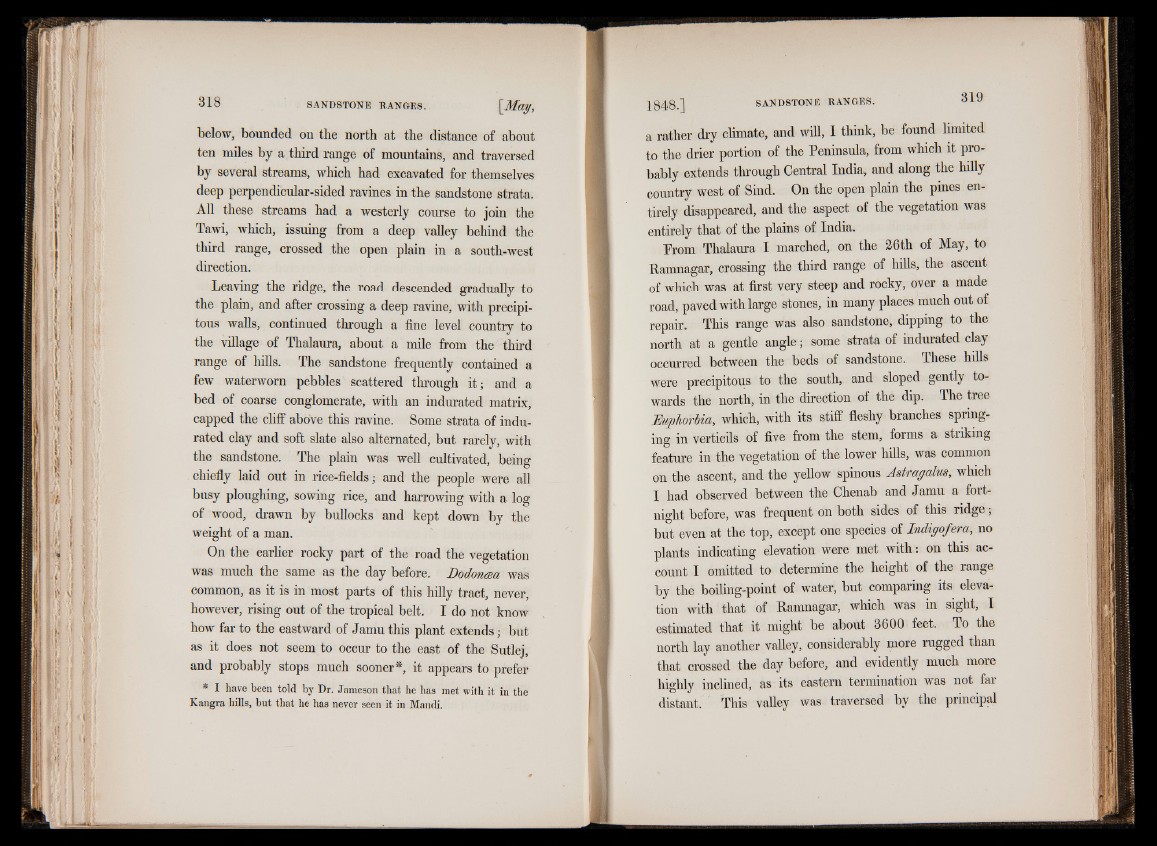
below, bounded on the north at the distance of about
ten miles by a third range of mountains, and traversed
by several streams, which had excavated for themselves
deep perpendicular-sided ravines in the sandstone strata.
All these streams had a westerly course to join the
Tawi, which, issuing from a deep valley behind the
third range, crossed the open plain in a south-west
direction.
Leaving the ridge, the road descended gradually to
the plain, and after crossing a deep ravine, with precipitous
walls, continued through a fine level country to
the village of Thalaura, about a mile from the third
range of hills. The sandstone frequently contained a
few waterworn pebbles scattered through it; and a
bed of coarse conglomerate, with an indurated matrix,
capped the cliff above this ravine. Some strata of indurated
clay and soft slate also alternated, but rarely, with
the sandstone. The plain was well cultivated, being
chiefly laid out in rice-fields and the people were all
busy ploughing, sowing rice, and harrowing with a log
of wood, drawn by bullocks and kept down by the
weight of a man.
On the earlier rocky part of the road the vegetation
was much the same as the day before. Dodoncea was
common, as it is in most parts of this hilly tract, never,
however, rising out of the tropical belt. I do not know
how far to the eastward of Jamu this plant extends; but
as it does not seem to occur to the east of the Sutlej,
and probably stops much sooner*, it appears to prefer
* I have been told by Dr. Jameson that he has met with it in the
Kangra hills, but that he has never seen it in Mandi.
a rather dry climate, and will, I think, be found limited
to the drier portion of the Peninsula, from which it probably
extends through Central India, and along the hilly
country west of Sind. On the open plain the pines entirely
disappeared, and the aspect of the vegetation was
entirely that of the plains of India.
Prom Thalaura I marched, on the 26th of May, to
Ramnagar, crossing the third range of hills, the ascent
of which was at first very steep and rocky, over a made
road, paved with large stones, in many places much out of
repair. This range was also sandstone, dipping to the
north at a gentle angle; some strata of indurated clay
occurred between the beds of sandstone. These hills
were precipitous to the south, and sloped gently towards
the north, in the direction of the dip. The tree
Euphorbia, which, with its stiff fleshy branches springing
in verticils of five from the stem, forms a striking
feature in the vegetation of the lower hills, was common
on the ascent, and the yellow spinous Astragalus, which
I had observed between the Chenab and Jamu a fortnight
before, was frequent on both sides of this ridge;
but even at the top, except one species of Indigofera, no
plants indicating elevation were met with: on this account
I omitted to determine the height of the range
by the boiling-point of water, but comparing its elevation
with that of Ramnagar, which was in sight, I
estimated that it might be about 3600 feet. To the
north lay another valley, considerably more rugged than
that crossed the day before, and evidently much more
highly inclined, as its eastern termination was not far
distant. This valley was traversed by the principal